City guides


Central Coast Travel Guide
California's central coast comprises some of the most spectacular shoreline, including the Monterey Peninsula and the Big Sur coast, where adventurers can marvel at gnarled trees, towering cliffs, rugged shores and enchanting bays.
The Pacific Coast Highway (also called Highway 1) stretches along most of California's coastline and, from San Francisco, it passes the small bayside city of Santa Cruz, with its famous Beach Boardwalk to the Monterey Peninsula. Called the 'Jewel of the Central Coast', Monterey's beauty has been immortalised by artists, writers and photographers, appearing in books such as John Steinbeck's and the black and white photographs of Ansel Adams. Its diverse cultural heritage is evident in its Spanish architecture and lively harbour and wharf district.
Monterey marks the northern edge of the wild and undeveloped Big Sur coast, with Highway 1 crawling along the edge of the rocky cliffs that hang precipitously over the crashing surf below. Big Sur refers to the entire 90-mile (145km) stretch of wilderness between Monterey and San Simeon. The often nerve-racking drive, especially when blanketed in thick fog, takes visitors along one of the most dramatic and exhilarating coastlines on earth, hemmed between the mountains of the Santa Lucia Range and the Pacific Ocean. The area provides a peaceful respite from the frantic energy of the cities, with little more to do than enjoy the mountains, cliff-top views and occasionally accessible beach coves.
The highway curves into the wealthy American Riviera town of Santa Barbara, an attractive coastal town with golden beaches, red-tile roofs and outdoor cafes.
Things to do in Central Coast
Big Sur, immortalised in song and literature, beckons travellers with art galleries, restaurants, redwood-filled state parks, steep canyons, dramatically beautiful coves and one breathtaking view after another. Highlights along this famous stretch include the much-photographed McWay Falls within Julia Pfeiffer Burns State Park, the Point Sur State Historic Park, Limekiln State Park, Salmon Creek Falls, and Ragged Point. Other big drawcards along the Pacific Coast Highway include Hearst Castle and Pinnacles National Monument, not to mention numerous incredible walking trails.
Popular travel hubs along this famous stretch include Monterey, one of the most picturesque cities in California, Santa Barbara, renowned as the glamorous 'American Riviera', and Santa Cruz, a small, laid-back city with a pleasantly bohemian atmosphere. The Central Coast of California is also home to many lifestyle retreats and luxury hotels in beautiful, sometimes secluded, natural surroundings, and it is easily possible to find accommodation outside of the big cities and towns.
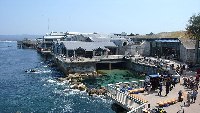
Monterey
One of the most beautiful cities on the central California coast, Monterey was originally the state capital of California and has a rich Hispanic heritage. Set on a stunning coastline of sandy beaches and rocky cliffs, Monterey is a relaxing place to enjoy outdoor activities such as golf, bicycling, surfing, kayaking and hiking. Monterey was the setting for some of John Steinbeck's most famous novels, and visitors can explore literary neighbourhoods such as Cannery Row and Fisherman's Wharf, which have many good art galleries and excellent restaurants serving freshly caught local seafood. The Path of History winds around Old Monterey (known as Monterey State Historic Park), and guided tours are available. There are several interesting museums in the area, including the Maritime Museum of History, Presidio of Monterey Museum, Old Whaling Station and Pacific House Museum. The Monterey Bay Aquarium is a great place to see local wildlife, including the abundant sea otter population. Children will also love the playgrounds and paddle boats at Dennis the Menace Park, and the interactive exhibits at the Monterey County Youth Museum. The surrounding region offers many additional attractions and excursions. The famous 17-Mile Drive has breathtaking coastal views through Pacific Grove and Pebble Beach, while the wineries of Carmel Valley offer wine tastings and tours. Point Lobos State Reserve and the State Parks comprising Big Sur make for an amazing afternoon drive and hiking session, and the pretty village of Carmel-by-the-Sea has idyllic beaches.
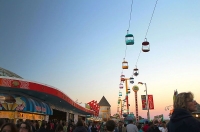
Santa Cruz Beach Boardwalk
Voted one of the world's best seaside amusement parks, Santa Cruz Beach Boardwalk is enjoyable for all ages with its collection of carnival rides, classic arcade games, and active pursuits such as mini golf, bowling and laser tag. Founded in 1907, Beach Boardwalk is also one of California's oldest amusement parks. Having recently received an upgrade, with the addition of two new thrilling rides, Santa Cruz Beach Boardwalk provides just as much fun and excitement as ever.
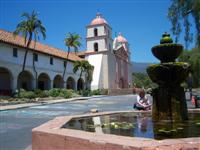
Santa Barbara
Santa Barbara is known as the 'American Riviera', thanks to its gorgeous weather, clean air, and beach-centred lifestyle. This attractive and historic coastal town is framed by the Pacific Ocean and Santa Ynez Mountains, and is located just off Highway 1, 80 miles (120km) north of Los Angeles. Santa Barbara has a character and laid-back energy all of its own, and attracts both wealthy weekenders and tourists seeking respite from the busyness of the larger urban centres to the north and south. Apart from relaxing on the fabulous beaches, there is plenty else to see and do here. Surrounding the beachfront are several popular bike trails, including local favourite the Cabrillo Beach Boulevard Bike Trail. Santa Barbara Channel is rated one of the world's best land-based whale watching sites, with over 30 different species of whales and dolphin viewable at different times of the year. The scenic waterfront is another major draw card, including Stearns Wharf, the oldest working wooden wharf in California. And if all that sightseeing and sun-tanning works up an appetite, travellers shouldn't miss the area's highly regarded Mexican food, which may be complemented by a tasting or two at one of over 100 local wineries. A tour of the town would ideally start at the beach front, from where State Street stretches into the historical and attractive downtown area. A stroll here will take visitors past charming boutiques, stores and eateries. The Spanish colonial-style buildings of the area reflect its history, although many are modern replicas built after the devastating 1925 earthquake. The surviving Santa Barbara Mission, built in 1786, is a landmark building, known for its twin bell towers and rolling green lawns (picnickers welcome); while the Santa Barbara Courthouse is renowned for its classical, stately proportions.
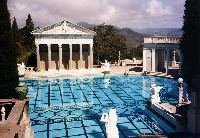
Hearst Castle
One of the most opulent mansions in the US, Hearst Castle was the residence of newspaper tycoon William Randolph Hearst. Built between 1919 and 1947, the residence was originally envisioned as a modest bungalow, but ballooned to a massive Spanish Revival castle. Located near San Luis Obispo, Hearst Castle is a popular tourist attraction along the Pacific Coast Highway in California. The magnificent residence has 165 rooms, including 56 bedrooms, 61 bathrooms and 19 sitting rooms, all richly decorated with ceilings Byzantine tapestries, Spanish and Italian art, fireplaces from Gothic castles and Egyptian statues. Other amenities at Hearst Castle include indoor and outdoor swimming pools, tennis courts, a movie theatre, airfield, and even a private zoo (zebras and a few other exotic animals still roam the grounds). The Neptune Pool especially is a highlight of the estate, offering panoramic vistas of the surrounding mountains and Pacific Ocean. The grounds, spreading across 250,000 acres (1,012 sq km), are bursting with colour as manicured gardens bloom with tulips, bougainvillea, lilies, gladiolus and agapanthus. Tours of Hearst Castle include a film of the estate's construction, and visitors can choose between several tours, including the Grand Rooms Museum, Upstairs Suites Museum, Cottages and Kitchen and Evening Museum Tour.
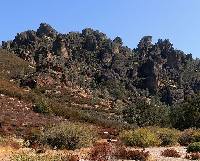
Pinnacles National Monument
The stunning landscape of Pinnacles National Monument offers visitors the opportunity to enjoy outdoor activities such as camping, hiking, rock climbing and birdwatching. The park gets its name from the eroded leftovers of half of an extinct volcano, which form the distinctive spires and crags. Talus caves like the Balconies and Bear Gulch Caves are popular attractions, and can be explored with flashlights. The park's location just off the US 101 highway makes it a convenient stop on any California road trip, offering a few hours active entertainment for families on holiday.
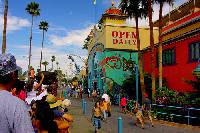
Santa Cruz
A small city at the north end of Monterey Bay, Santa Cruz is a fun weekend getaway with a bohemian atmosphere. Popular tourist attractions such as the picturesque Beach Amusement Park and Boardwalk are great for families, and the beaches are some of the best along the California coast. One of the most famous attractions in Santa Cruz is the Mystery Spot, a kind of tilt-induced visual illusion known as a gravity hill. The effect is that the laws of physics and gravity seem to be turned on their heads, causing misperceptions of height and orientation.
United States of America travel info
Electricity
The electrical current is 120 volts, 60Hz. Plugs are mainly the type with two flat pins, though three-pin plugs (two flat parallel pins and a rounded pin) are also widely used. European appliances without dual-voltage capabilities will require an adapter.
Language
English is the most common language spoken but Spanish is often heard in the south-western states.
Money
The official currency is the US Dollar (USD), which is divided into 100 cents. Only major banks exchange foreign currency. ATMs are widespread and credit cards are widely accepted; Apple Pay and Google Pay are very popular. Banking hours are Monday to Friday 9am to 3pm.
Tipping
A 15 percent tip is expected by taxi drivers, bartenders, hairdressers and waiters, but travellers shouldn't tip in fast-food or self-service restaurants. In expensive restaurants or for large parties, the tip should be 20 percent of the bill. It's normal to tip staff such as valets and porters in hotels; this is discretionary, although a minimum of $5 is expected. Most services are customarily tipped if the service is good.
Health
There are no specific health risks associated with travel within the USA. Medical facilities are excellent, but expensive. Only emergencies are treated without prior payment and treatment can be refused without evidence of insurance or proof of funds. Good medical insurance is essential.
Safety
Travel within the United States is generally trouble-free, though travellers should be aware that the US shares with the rest of the world an increased threat from terrorist incidents. Security has been heightened, particularly at airports. Restrictions on hand luggage apply and travellers are advised to check on the latest situation with airlines in advance. Travellers should also be alert to the dangers of car and street crime in cities and should use common sense and take basic precautions. Hurricanes are common between June and November, putting the southern USA, including the Gulf Coast and the eastern US at risk. There's a risk of wildfires in many dry areas in the US, particularly on the West Coast from March to November.
Local customs
Laws vary from state to state, including speed limit, fines and punishment. The age at which alcohol may be legally bought and consumed is 21 years.
Doing business
In such a large country, filled with so many diverse groups, business practices may differ according to each state, though rarely to any large degree. The East Coast is traditionally more formal than the West Coast, though in states such as California, dress code and conservative appearance are as common as they would be in New York. Punctuality is important throughout the country and it's considered rude to be late for a meeting. Gift-giving is uncommon as it may be construed as bribery. Appropriate titles (Mr, Mrs, Ms) are used upon introduction and until otherwise stated. Americans favour politeness and greetings of 'Hello' and 'How are you?' are often expressed with sincerity. Business hours may vary in each state, but an 8am start and 5pm finish Monday to Friday is the most common with an hour over lunch.
Status and age are not necessarily indicative of seniority, nor do they carry much weight in themselves. Those doing business in the States should be mindful of this fact; foreigners should never make assumptions about someone's position or rank. Best practice is to be respectful to all parties. That said, the US upholds a hierarchal business structure in which 'the boss' is the ultimate decision-maker. Senior leaders have the power of the last word, and can go against the grain just as easily as they can follow popular opinion. Foreigners should concentrate on winning over this individual, even if the greater group seems unsupportive. Americans value a direct style of communication. In this fast-paced, consumer culture 'time is money', and small-talk is viewed as unnecessary and wasteful. It's best for foreigners to get to the point quickly, speak about issues in a frank and open manner, and to avoid taking offence if someone questions or challenges them outright.
Duty free
Travellers to the United States who are returning residents of the country do not have to pay duty on articles purchased abroad to the value of $800 provided their stay was longer than 48 hours and their duty-free allowance was not used in the 30-day period prior. For passengers arriving from Samoa, Guam and the U.S. Virgin Islands, a duty-free allowance of $1,600 is allowed. The following items are included in this: 50 cigarettes and 10 cigars and 150 millilitres (5 fl. oz.) of alcoholic beverages or 150 millilitres (5 fl. oz.) of perfume containing alcohol. Restrictions may apply to goods from Cuba, Iran, North Korea, Burma (Myanmar), Angola, Liberia and Sudan. It is prohibited to import Cuban cigars from any country.
Travellers to the United States who are non-residents do not have to pay duty on the following items: 50 cigars or 200 cigarettes and gifts to the value of $100 provided their stay in the USA is not less than 72 hours and that the allowance has not been used in the preceding six-month period.
Prohibited items for residents and non-residents include meat or meat products, poultry, narcotics, absinthe, plants, seeds, vegetables, fruits, soil, live insects and other living plants or animal pests. Fish is prohibited unless it carries disease-free certification. Wildlife and animals or their by-products carry restrictions. Dairy products and eggs from specified countries are not allowed. Firearms and ammunition are not allowed without the necessary license and permit.
Communications
The international country dialling code for the United States is +1. Mobile networks cover most of the country, especially all urban areas; travellers can purchase local prepaid SIM cards for unlocked phones or use eSIMs if their cellular providers support it on their networks. WiFi is widely available.
Passport & Visa
It is highly recommended that travellers' passports have at least six months' validity remaining after the intended date of departure from them travel destination. A visa is required for short visits unless travellers qualify for entry under the Visa Waiver Program.
The Visa Waiver Program (VWP) enables citizens of certain countries to travel to the US for a stay of up to 90 days without a visa. Visitors under the VWP need a valid Electronic System for Travel Authorization (ESTA), which allows the US government to screen all visitors before travel. Visitors entering the country under the VWP must have a machine-readable passport (MRP) that has a barcode on the photo page. Travellers under the VWP must have passports that include biometrics if they wish to enter the country without a visa, which means that passports must contain unique personal data such as fingerprints or iris details. All passports must contain a digital photo image in order to travel visa-free. All visitors to the USA have a photograph and two fingerprints taken by an inkless scanner on arrival, including those travelling visa-free under the VWP.
As part of the Western Hemisphere Travel Initiative (WHTI), all travellers travelling between the United States and Canada, Mexico, Bermuda, and the Caribbean region are required to present a passport or other valid travel document to enter or re-enter the United States. If departing from the USA, a valid passport is required by immigration authorities. Immigration officials often apply different rules to those stated by travel agents and official sources.
Entry requirements
US citizens require passports.
UK nationals require a passport valid for duration of stay. Most passport holders can get an Electronic System for Travel Authorisation (ESTA) through the Visa Waiver Programme, which allows travel to the US for up to 90 days. The VWP includes tourism, certain types of business visit and transit to another country.
The most important requirement on entering the U.S. is providing proof of Canadian citizenship. A valid Canadian passport is the best document to prove Canadian citizenship and the right to return to Canada. However, several other documents can serve, depending on the mode of transport. Generally, Canadian citizens do not require visitor, business, transit or other visas to enter the United States from Canada, though there are some exceptions.
Passports must be valid for the period of intended stay. If visiting the US for fewer than 90 days, Australian nationals may be eligible to apply for an Electronic System for Travel Authorization (ESTA), and enter under the Visa Waiver Program (VWP).
South Africans must hold a passport valid for duration of stay. A visa is required.
Passports must be valid for duration of stay. Irish nationals can get an Electronic System for Travel Authorisation (ESTA) under the Visa Waiver Programme for entry into the United States.
Passports must be valid for duration of stay. New Zealand nationals can get an Electronic System for Travel Authorisation (ESTA) under the Visa Waiver Programme for entry into the United States.
Useful contacts
United States Tourist Office: www.usatourist.com
911 (General)Embassies / consulates in other countries
United States Embassy, London, United Kingdom: +44 20 7499 9000.
United States Embassy, Ottawa, Canada: +1 613 688 5335.
United States Embassy, Canberra, Australia: +61 2 6214 5600.
United States Embassy, Pretoria, South Africa: +27 12 431 4000.
United States Embassy, Dublin, Ireland: +353 1 668 8777.
United States Embassy, Wellington, New Zealand: +64 4 462 6000.
Embassies / consulates in United States of America
British Embassy, Washington DC: +1 202 588 6500.
Canadian Embassy, Washington DC: +1 202 682 1740.
Australian Embassy, Washington DC: +1 202 797 3000.
South African Embassy, Washington DC: +1 202 232 4400.
Irish Embassy, Washington DC: +1 202 462 3939.
New Zealand Embassy, Washington DC: +1 202 328 4800.


